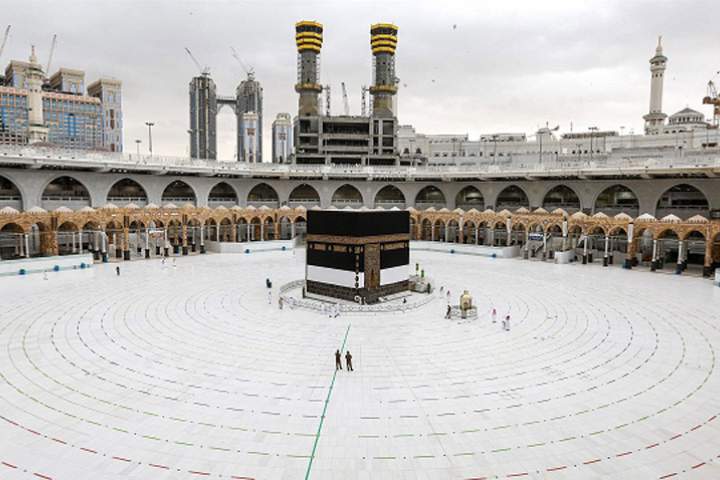Annual Hajj rituals have begun in Makkah with the arrival of pilgrims in Mina.
Publish dateWednesday 29 July 2020 - 15:46
Story Code : 215793
Only around one thousand pilgrims will perform Hajj this year due to crowd control restrictions put in place by Saudi Arabia in the wake of Covid-19 pandemic. Normally, over two million people perform Hajj.
For the first time in decades, international travelers have been barred from the Hajj due to Coronavirus pandemic. Some seventy percent of the worshippers this year are foreign residents of Saudi Arabia, with the rest being Saudi nationals. All of those selected to take part are aged between 20 and 50.
As part of precautionary measures, the pilgrims will wear face mask and observe social distancing. The Saudi authorities have also banned touching Khana Kaaba and Hajr-e-Aswad.
Pilgrims will remain in Mina until Fajr next morning, the 9th Dhul Hijjah. Then the Hujjaj will proceed to the valley of Arafat and offer Duhr and Asr prayers. The Hajj sermon will be delivered at Masjid-e-Nimra in Arafat. The same day, pilgrims will leave for Muzadalifah after sunset without offering Magrhrib prayer to be said along with Isha in Muzdalifah. They will spend the whole night in Muzalifah under open sky and rest there until Fajr prayer. In Muzdalifah, the Hujjaj will pick up 70 pebbles to perform ritual of Rammi by stoning the Shaitan.
After offering Fajar prayer on 10th of Dhul Hijjah in Muzdalifah, pilgrims will move to Jamaraat and pelt stones on the largest Jamra, representing the devil. Then a sacrifice should be made in which a lamb or sheep is slaughtered. After this, men's heads are shaved, while women cut a lock of their hair and the pilgrims remove their Ihrams and wear normal clothes. Then the Hujjaj will do Tawaf-e-Ziarat and Sai and return to their tents in Mina. The pilgrims will pelt seven pebbles on three each Jamra or Shaitan on 11th and 12th of Dhul Hijjah and leave Mina before sunset. Finally, pilgrims will do a farewell Tawaf in Masjid-al Haram before leaving the holy land to complete their Hajj.
For the first time in decades, international travelers have been barred from the Hajj due to Coronavirus pandemic. Some seventy percent of the worshippers this year are foreign residents of Saudi Arabia, with the rest being Saudi nationals. All of those selected to take part are aged between 20 and 50.
As part of precautionary measures, the pilgrims will wear face mask and observe social distancing. The Saudi authorities have also banned touching Khana Kaaba and Hajr-e-Aswad.
Pilgrims will remain in Mina until Fajr next morning, the 9th Dhul Hijjah. Then the Hujjaj will proceed to the valley of Arafat and offer Duhr and Asr prayers. The Hajj sermon will be delivered at Masjid-e-Nimra in Arafat. The same day, pilgrims will leave for Muzadalifah after sunset without offering Magrhrib prayer to be said along with Isha in Muzdalifah. They will spend the whole night in Muzalifah under open sky and rest there until Fajr prayer. In Muzdalifah, the Hujjaj will pick up 70 pebbles to perform ritual of Rammi by stoning the Shaitan.
After offering Fajar prayer on 10th of Dhul Hijjah in Muzdalifah, pilgrims will move to Jamaraat and pelt stones on the largest Jamra, representing the devil. Then a sacrifice should be made in which a lamb or sheep is slaughtered. After this, men's heads are shaved, while women cut a lock of their hair and the pilgrims remove their Ihrams and wear normal clothes. Then the Hujjaj will do Tawaf-e-Ziarat and Sai and return to their tents in Mina. The pilgrims will pelt seven pebbles on three each Jamra or Shaitan on 11th and 12th of Dhul Hijjah and leave Mina before sunset. Finally, pilgrims will do a farewell Tawaf in Masjid-al Haram before leaving the holy land to complete their Hajj.
Source : Afghan Voice Agency(AVA)
avapress.net/vdcgyn9xwak9qu4.5jra.html
Tags
Top hits







